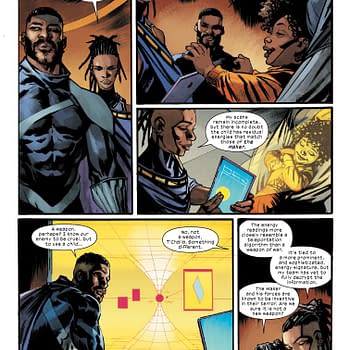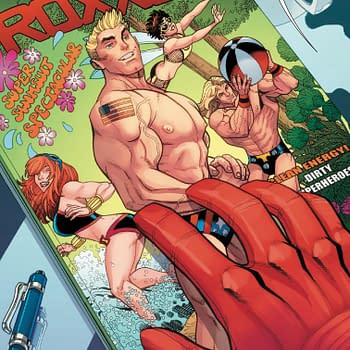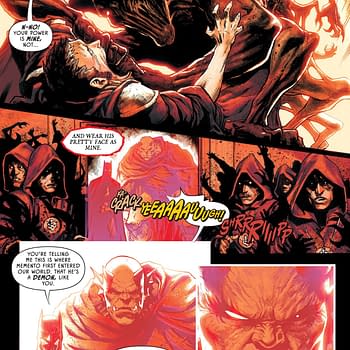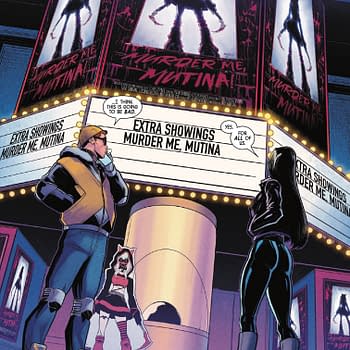Posted in: Comics, Recent Updates | Tagged: brad pitt, cameron stewart, chuck palahniuk, Comics, dark horse comics, edward norton, entertainment, Fight Club 2, free comic book day
Cameron Stewart Tells Us 'Every Single Person Is Wrong' About Fight Club 2 – Plus Original 'Try Out' Pages
This week, the first new Fight Club story to hit comics format arrives with Dark Horse's Free Comic Book Day comic. Written by the Fight Club novel's author Chuck Palahniuk, drawn by Cameron Stewart, with colors by Dave Stewart, the story included in the FCBD issue serves as an epilogue to the novel's Fight Club story, containing the "original" ending to the novel which is different from David Fincher's film version, and helps create a "bridge" that will guide readers through into the new series from Dark Horse, Fight Club 2 arriving in May. This story creates a "bridge" in many ways because it sets up the visual language of the new comic. Here you'll meet characters for the first time in comics form, see the dynamics of their relationships, and also the tensions that led to the disappearance of Tyler Durden.

Cameron Stewart joins us here to talk about Fight Club for Free Comic Book Day, Fight Club 2, and his "try out" pages we'll be revealing below. Since he lives in the UK, he's seen Avengers: Age of Ultron already, so we talk him into giving his thoughts on the film as well.
HMS: Seeing the Free Comic Book Day story, which I have just received, having already read the first issue of Fight Club 2, and the try out pages previously, really points out to me the elements early on that have been developed as part of the storytelling.
CS: The three page "audition" was something I knocked out over a weekend, really quickly. It was enough to give Dark Horse an idea of where I wanted to go, but there was a lot of work that went into it subsequently to develop the characters.

HMS: Most people who will be viewing these pages here today would be amazed, and find it hard to believe that you did it in such a short period of time, since it looks so professional and polished.
CS: Well, I am a professional! (Laughs) When it's called for, I can actually be pretty fast. I drew the Free Comic Book Day story in 4 days.
HMS: That's amazing! I feel like I'm talking to a super-human now. There's probably a lot of thought that goes into it for you, though, beyond the actual process of drawing it. In the try out pages, I noticed that you didn't focus on the faces much, and use a lot of shadow. Is that a specific technique or driven by the fact that you weren't sure yet how you wanted characters to look?
CS: Well, on the first page, I wanted to not focus on Tyler's face because he's not real. He's a figment of Sebastian's imagination. So I felt it was appropriate for that page to focus more on aspects of his face. You see the close-up of his mouth, rather than his full face, and the like. But yes, it was also that I wasn't sure how I wanted them to look yet. It was interesting for me because I think I drew Tyler closer to how he appears in the film, without trying to draw Brad Pitt exactly. Because I knew that we wouldn't be following the likenesses of the actors. The film's visuals are the property of 20th Century Fox anyway, and I knew we wouldn't be drawing Edward Norton and Brad Pitt. But I did want to go with something that was sort of reminiscent of them.
I had read the novel years ago, but something I hadn't really picked up on was that Tyler has always been meant to have long hair. That was something in Chuck's mind, that Tyler has long chin-length or shoulder-length hair. So when it came time to draw the comic, I made sure to include that.
HMS: And that's visible in the Free Comic Book Day issue, though not in the try out pages.
CS: Yes. I initially drew the character based on my impressions, and then Chuck gave me some notes on the long hair, and I incorporated it. Most people are going to think of Tyler Durden as looking like Brad Pitt. Even if you know the novel, I think that image is very strongly associated with the character. It's a particular challenge to draw a character where everyone knows what he looks like and I have to make him look nothing like that, and yet somehow look immediately recognizable as that character. It's like, "Redesign Darth Vader and make it so people immediately know it's Darth Vader but it can't look anything like Darth Vader" (Laughs). It's an immediately weird challenge to do it. Hopefully I will have succeeded.
Part of the point of the FCBD story, which is sort of a retelling of the end of the novel, is that it will condition people to how these characters look now, before readers gets into the main series.

HMS: Well, it's possible since you're working directly with Chuck also, that he might provide information about characters that isn't even present in the novel, and that could influence your portrayal, right?
CS: Absolutely. Completely. It's funny, too, because he's quite open to collaboration and revision. There's been a lot of revision by him throughout the process. He's very generous as a collaborator. There was the potential concern that having a writer in total control of a property might result in the writer exerting too much control over the process, but that hasn't been the case. He's taken my ideas, and Scott [Allie's] ideas on board. Even some minor mistakes I've made through misreading the script or leaving a panel out have led him to roll with it, and he has altered the script to accommodate them. It's great because it feels like a less rigid project, and I feel less like I'm adapting someone's work and more like I'm collaborating on something.
HMS: I've heard stories, I think from Scott Allie, about the ferocity with which Chuck has gone after learning about the comics medium, reading tons of stuff.
CS: Yes. I was in a meeting with him a couple of weeks ago, and he said that now that I have gotten a few issues in the can, he's learning more about how I work and my methods, so now he's revising all the subsequent scripts based on that. He's written the whole thing already, which is quite rare for comics. He delivered 10 scripts off the bat, which I've never had before. But now he's rewriting them based on what he's seen of how I translate his scripts, so that the whole thing will be more harmonious.
HMS: It's like the comic is developing its own visual language over time?
CS: Sure. No matter how much preparatory work you may do, a comic always develops over time. The later issues always end up looking different than the earlier ones.
HMS: Could I ask, on a personal level, why this project attracted you?
CS: Like most people, I saw the film when it came out and really liked it. Then I read the book because of that, and I just became a Palahniuk fan. I have read most of his books, though not all, about 80 % of what he's written. I like his style. He's been one of my favorite writers, whom I find quite reliable in terms of liking what he's written. When I first heard about this project, it seemed like a curiosity. I didn't think I'd be involved in it. I thought, "That's weird and not what I was expecting to hear". You don't expect to hear about a sequel, and certainly not that the sequel is going to be a comic book. You get licensed properties where publishers attempt to squeeze some blood out of that stone. They hire writers to do it and so on.
But in this case, it was a writer approaching a publisher and saying, "I want to do it and I want to do it as a comic". When I heard that it was possibly going to be through Dark Horse, I thought that it would be very cool to work on. I had images in my head, the potential of what it could be, so I contacted Scott [Allie] and said, "Look if you are going to do this, I'd like to be the one to do it". That was when those try out pages happened. They weren't sure yet how they wanted the comic to look, and were considering different artists. Chuck didn't have a lot of experience with different comics or art styles, so in my own time, unasked, I did these pages to show my interest and my dedication to it. It was fun. And it worked. It got me the job.
HMS: I've heard some of the story from the other perspective of how excited Dark Horse were by your tryout pages, that the choices you made in layout and design were so intelligent that it won them over.
CS: I think that it was only after Scott Allie got the scripts from Chuck and read through them, and then saw my try out pages, that he felt at that point there was nobody else who could do it.
HMS: And of course, you've worked with Dark Horse before on Sin Titulo and B.P.R.D.
CS: Yes, that's right.

HMS: Is there anything that you see when you look at the tryout pages that makes you think, "This is exactly where I ended up going", or "This is what I didn't want to do in the end"?
CS: I'm still trying to keep a lot of the same flavor to it. One thing on the main comic that I'm still doing, is I'm using a fairly tight grid for most of it. Just because I quite like working in a clean grid. Because of the density of the story and the density of the information in the script—and Chuck writes a lot of panels—I felt like sticking to a fairly tight grid was the way to go. And then when it's necessary, like a flashback sequence or a fantasy sequence, then I can break out into a little more experimental or ostentatious page layout.
Aside from the changes in the characters, the try out pages are still fairly representative of how the book looks, short of stuff that Scott, Chuck, and I discussed in our creative meetings about how we can take the book further or how we can make it stand out from other comics.
HMS: Well, there's a visible alternation—as you just mentioned—between the tight grids, which are incredibly useful, and the bigger spreads. Because you can use them to suggest different beats so clearly…
CS: Yes, and there's a rhythm to way that Chuck writes, too. If you're familiar with his work, he tends to write these very short, often single-line paragraphs with a repetition to them. Sometimes he'll do this thing where he'll repeat lines. It creates a kind of rhythmic effect, which works very well in an ordered grid. The script is written in such a way that I can see it in a grid form, just based on the rhythm of his writing.
HMS: And that actually makes it even more impactful and interesting when you break away from that, and have an open structure format for a whole page. Then you might have some kind of other ordering structure, like time, I've noticed. There's a prominent spread to look out for in the try out pages, where an LED clock is involved to mark time. Is the layout alternation a way of keeping it fresh for you, too, so you aren't too trapped in repetition?
CS: Yes, absolutely. When I'm going through the script, if there's a particular image that makes me I wonder if something is going to have greater impact if I break away from the grid, then I might do that. It's all about contrast, and saving things for when they are most effective rather than overdoing either approach.
So, to give an example from the first issue of Fight Club 2, and I don't think it's really a spoiler to say that Tyler returns at this point, there's a sex sequence between Sebastian and Marla where Tyler re-emerges which is played as kind of a dream sequence. That was an instance when the contrast of the sexual imagery and some disaster footage was something that would look more interesting in a strange kind of montage than in an ordered grid. I use a different format when it's meant to be something that's breaking out of sequence, like if someone's telling a story, or for a flashback or a dream.

HMS: Were there particular benefits or stresses in creating the FCBD story and knowing that virtually anyone might read it for free, and yet it needed to be accessible to them?
CS: I think for most people, they will be familiar with the film over the novel and the film ends differently than the novel. We wanted to make sure that people were coming to the comic book understanding that it's a continuation of the novel and not the film, first of all, and then also receiving a recap of how the novel ended to prime them for the series.
HMS: The comic conveys some information they might not even know.
CS: Yes, and it contains some new information from Chuck not in the novel. For instance, the revelation that Marla is pregnant, that's also a way of setting up the new series.
HMS: Something that Rich Johnston has pointed out about the FCBD story is that the 9/11 foreshadowing imagery that the novel is reputed to have turns up more directly here as an overt thing. That's been part of the discussion of the Fight Club novel after it was written, that is seems to have an eerie resonance with the later events of 9/11.
CS: Actually, I'm not sure. This is new information to me. In what respect?
HMS: In the FCBD story, there's a panel where someone comments on the ability of a small group of people to be destructive (I'll stay vague to avoid spoilers).
CS: That would be a question for Chuck. I didn't particularly read it that way.
HMS: Oh, right. Our mistake. It's possible that 9/11 is so much a part of our public consciousness now that it's impossible to "unsee" potential references to it.
CS: Perhaps it is, but that's not necessarily how I read it. But that's art for you, people's interpretations are different. I actually believe in the "death of the author" and that people's interpretations are as valid as what's intended by the writer. 9/11 didn't actually enter into my mind for that.
HMS: Well, it's set during a significant scene anyway, so either way, there are more important elements to the plot going on that take precedence.
Here's another question for you that I hope isn't too high-brow: What do you think are the strengths of the comics medium when it comes to portraying psychological states. Do you think that comics might be better or even more effective than film in portraying altered states of mind?
CS: Well, one of the reasons that Chuck said he liked my work and one of the reasons I was hired for the job—and I think that a lot of people were surprised when they heard that I was doing it—that I quite often have the reputation for being "cartoony"–and I'm making air quotes when I say that. Because I don't often draw in a Bryan Hitch way or an Alex Maleev way. I draw in a way that's kind of abstracted from reality a little bit. What that allows is a bit of latitude in the way that the story is presented. One of the things Chuck has said is that if this material was presented realistically it might be too upsetting and too disturbing. By abstracting it, and putting it in a comic, and having it drawn in a way that's not quite a realistic rendering, that can be quite effective. It can still read as disturbing, but in a way that's not off-putting. And also in a way that highlights the comedic aspects of it. I think Chuck's work has always been quite funny.
HMS: Yes.
CS: He's writing satirically, and I think that taking it at face value—which can happen when you have film actors—is that it has the opposite effect of being comedic. By drawing it in this way, I think that it underlines the heightened absurdity of it.

HMS: I was going to ask you about humor, because there is plenty of it in Issue #1 of Fight Club 2. It's constantly "popping" and standing out against everything else. Maybe people are going to find it even funnier than the film, depending on how they interpreted the film. Because if you talk to friends about it, one might say it was a hilarious film, and another might say it was incredibly dark.
CS: Sure. I think people have very different interpretations of Fight Club and it means a lot of very different things to them. I think it's going to be very interesting to see, particularly as the series plays out, how people take it. Because I think it is going to be a bit of a rug pulled out from under people. Most people have an idea in their mind of what a Fight Club sequel is, and I am absolutely confident in saying that every single person is wrong.
This is not at all what they are expecting. It's going to be interesting to see how people who view Fight Club in a particular way take this series, because it goes pretty far off the rails. It's quite comedic, and it's quite meta-fictional. There's a part in the fourth or fifth issue that, when reading it, recontextualized everything for me. It's such a strange, bizarre comic, and I think it becomes as much a commentary on how Fight Club has been received in culture, as a sequel to the story.
HMS: Of course, because Chuck Palahniuk himself will have been influenced by observing that reception over time.
CS: Absolutely, yes.
HMS: It seems to me that it's almost like he's taking it back from the public consciousness and tweaking it closer to his own specs. It's as if he's reasserting his particular view of it, if not some kind of original view, then at least the way he sees it now.
CS: Yes. There's a bit of a tension towards the end of the series that I think is very much about that. It's about taking it back, but questioning whether it can actually ever truly be taken back. That is played out in the closing chapters.
HMS: Is this the most information, in terms of density, that you've ever tried to convey on a comics page?
CS: Oh, I don't know about that. It is, in a sense, but one of my endless frustrations, particularly with the American comics industry, is the page count. How we're limited to 20 or 22 pages every month. Quite often the stuff that I want to do requires more space than that. So I've often had to compromise. When I'm doing Batman or Batgirl, in a lot of my action sequences I'm having to cram in a ton of tiny panels, just to contain the amount of information that I need to get across and the number of story beats necessary. I have to really force it all into a limited space. I think I'm used to having to do a lot of dense detail, but usually it's for action stuff, whereas this has dense pages that are in service of story and character. It also jumps around between different perspectives.
So, I have experience with it. I'm not someone who's uncomfortable with drawing a 19 panel page…
HMS: (Laughter) Sorry. That's…wow.
CS: It's a lot of work. I don't necessarily enjoy that, but I do have experience of it, whereas I think some people would find it a really impossible challenge. But one of the great things about working on this is that Scott has basically said I can have as many pages as I need. It's not over-indulgent permission—I'm not going to turn in a 60 page issue. But if at story or an issue needs to be 25 pages rather than 22, then they've given me the permission to do that. I think that there have been parts that needed it. I've sometimes thought, "If I had one or two extra pages to do that, it would be great", and I can do that.
HMS: Do you think that the fact that you're a writer as well has enabled you the right person for this project, since you're handling such a literary body of material?
CS: Yeah, probably. When I'm reading the script I think that I understand what Chuck is trying to convey as a writer and how I can effectively translate that into a drawn page.

HMS: I'm sorry if all my questions are about serious aspects of the project. Is this also a fun project for you?
CS: Yeah, of course. It absolutely is. Like any project that I've worked on, there are moments where because of deadlines, it ceases to become fun and becomes a job. There's a lot of pressure on me for this. This is something that is not going to be seen just by the comics community, but unquestionably it will also be seen by the literary community. It will be seen by fans of Chuck's writing, fans of the movie, and I'm certain a copy of it will end up on some movie execs desk. There are a lot of people who will be looking at this with a very critical eye. There's definitely a ton of pressure involved, moreso than I feel on other things. I'm trying to make sure that I do the best possible job on it so there are definitely times when it becomes more of a grind when I know I have to produce on a schedule. In my ideal world, I'd have as much time on it as I think it needed, but if that happened I'd take 7 years to do it. (Laughs)
There's always the commercial reality of having to produce something on a schedule and the artistic satisfaction of doing something that pleases you. There's a good balance, I think. But yes, I'm having fun doing it, and there's an opportunity to draw a lot of interesting…things, that I probably wouldn't have drawn on my own. There's always something new. There are things that I've had to google search that you don't want to know. But that's what you get working with Chuck. You know you're going to have to deal with some unsettling imagery.
The new Fight Club story can be found in Dark Horse's Free Comic Book Day issue which also contains a Goon feature.
The first issue of Fight Club 2 arrives on May 27th and is currently listed in Previews World with item code: MAR150015.
In the meantime, make sure to Joinprojectmayhem.com to find out what's up with Fight Club 2 and read the eerie Tweets of Tyler Durden.

















